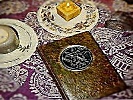
Sacred Texts Index Previous Next


Internet Book of Shadows, (Various Authors), [1999], at sacred-texts.com
By: Alex Rigel
Source: "An ABC of Witchcraft", Doreen Valiente, 1973, Phoenix
publishing inc., Wash. pp.203-4.
"Initiations.
When witchcraft became an underground organisation, the Craft of
the Wise, it shared a characteristic common to all secret societies.
Admission to it was by initiation.
Such initiation required the newly admitted member to swear a
solemn oath of loyalty. When witchcraft was punishable by torture and
death, such an oath was a serious metter. Today, when witchcraft has
become like Freemasonry, not a secret society but a society with
secrets, the idea of initiationj still remains.
Initiations into witch circles nowadays take varying forms, as they
probably always did. However, the old idea that initiation must pass
from the male to the female, and from the female to the male, still
persists. A male with must be initiated by a woman, and a female witch
by a man. This belief may be found in other forms, in traditional
folklore. For instance, the words of healing charms are often required
to be passed on from a man to a woman, or from a woman to a man.
Otherwise, the charm will have no potency.
There is also an old and deep-seated belief, both in Britian and in
Italy, that witches cannot die until they have passed on thier power to
someone else. This belief in itself shows that witchcraft has been for
centuries an initiatory organisation, in which a tradition was handed on
from one person to another.
The exception to the rule that a person must be initiated by one of
the opposite sex, occurs in the case of a witch's own children. A mother
may initiate her daughter, or a father his son.
In general, for their own protection, covens have made a rule that
they will not accept anyone as a member under the age of 21. Witches'
children are presented as babies to the Old Gods, and then not admitted
to coven membership until they have reached their majority.
This rule became general in the terms of persecution. Secrecy upon
which people's lives depended was too great a burden for children's
shoulders to bear. It is evident, from the stories of witch
persecutions, that witch-hunters realised how witchcraft was handed down
in families. Any blood relative of a convicted witch was suspect.
The witch-hunting friar, Francesco-Maria Guazzo, in his 'Compendium
Maleficarum' (Milan, 1608, 1626; English translation edited Montague
Summers, London, 1929), tells us that "it is one among many sure and
certain indications against those accused of witchcraft, if one of their
parents were founded guilty of this crime". When the infamous Matthew
Hopkins started his career as Witch-Finder General, the first victim he
seized upon was an old woman whose mother had been hanged as a witch.
There are a number of fragmentary accounts of old-time witch
initiations, and from these a composite picture can be built up. The
whole-hearted acceptance of the witch religion, and the oath of loyalty,
were the main features. There was also the giving of a new name, or
nick-name, by which the novice was henceforth to be known in the novice
was given a certain amount of instruction, and, if the initiation took
place at a Sabbat, as it often did, they were permitted to join in the
feast and dancing that followed.
In some cases, in the days of really fierce persecuation, a
candidate was also required to make a formal renunciation of the
official faith of the Christian Church, and to fortify this by some
ritual act, such as trampling on a cross. This was to ensure that the
postulant was no hypocritical spy; because such a one would not dare to
3105
commit an act which he or she would believe to be a mortal sin. Once the
postulant had formally done such an act, they had in the eyes of the
Church damned themselves, and abandoned themselves to hellfire; so it
was a real test of sincerity, and an effective deterrent to those who
wanted to run with the hare and hunt with the hounds. Such acts are not,
however, to my knowledge, required of witches today.
One of the ritual acts recorded as being part of a witch initiation
is that described by Sir George Mackenzie, writing in 1699 about
witchcraft in Scotland, in his book 'Laws and Customs of Scotland"
(Edinburgh, 1699): "The Slemnity confest by our Witches, is the putting
one hand to the crown of the Head, and another to the sole of the Foot,
renouncing thier Baptism in that posture." Joseph Glanvill's book
'Sadducismus Triumphatus' (London, 1726), had a frontispiece of pictures
illustrating various stories of mysterious happenings, and one of these
old woodcuts shows a witch in the act of doing this.
Her initiation is taking place out of doors, in some lonely spot
between two big trees. With her are three other women, one of whom seems
to be presenting her to the devil, who appears as the conventional
figure of a horned and winged demon. In practice, however, the devil of
the coven was a man dressed in black, who was sometimes called the Man
in Black, for this reason. The "grand array" of the horned mask, etc,
was only assumed upon special occasions.
A variant of this ritual was for the Man in Black to lay his hand
upon the new witch's head, and bid her to "give over all to him that
was under his hand". This, too, is recorded from Scotland, in 1661.
Information about the initiation of men into witchcraft is much
less than that referring to women. However, here is an account from
the record of the trial of William Barton at Edinburgh, about 1655,
evidently partly in his words and partly in those of his accusers, which
tells how a young woman witch took a fancy to him, and initiated him:
One day, says he, going from my own house in Kirkliston, to the
Queens Ferry, I overtook in Dalmeny Muire, a young Gentlewoman,
as to appearance beautiful and comely. I drew near to her, but she
shunned my company, and when I insisted, she became angry and
very nyce. Said I, we are both going one way, be pleased to accept
of a convoy. At last after much entreaty she grew better natured,
and at length came to that Familiarity, that she suffered me to
embrace her, and to do that which Christian ears ought not to hear
of. At this time I parted with her very joyful. The next night,
she appeared to him in that very same place, and after that which
should not be named, he became sensible, that it was the devil.
Here he renounced his baptism, and gave up himself to her service,
and she called him her beloved and gave him this new name of John
Baptist, and recieved the Mark.
The Devil's amke was made much of by professional witch-hunters,
being supposed to be an indelible make given by the devil in person to
each witch, upon his or her initiation. However, it would surely have
been very foolish of the devil to have marked his followers in this way,
and thus indicated a means by which they mightalways be known. From the
confused descriptions given at various times and places, it seems
evident that the witch-hunters knew there was some ceremony of marking,
but did not know what it was.
In witchcraft ceremonies today, the new initiate is marked with
oil, wine, or some pigment, such as charcoil. However, as Margaret
Murray has pointed out, there is a possibility, judging by the many old
3106
accounts of small red or blue markings being given, the infliction of
which was painful but healed after a while, that this may have been a
tattoo mark. Ritual tattooing is a very old practice; and some relics of
this survive today, in the fact that people have themselves tattooed
with various designs 'for luck'. However, when persecution became very
severe, it would have been unwise to continue this form of marking.
The most up-to-date instance I have heard, of the marking of new
initiates, is the practice of a certain coven in Britian today, which
uses eyeshadow for this purpose; because it is available in pleasing
colours, is easily washed off, and does no harm to the skin. One wonders
what old-time witches would think of it!
................................................................................
3107